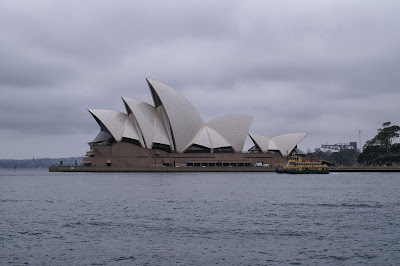The Sydney Opera House is a multi-venue performing arts centre in Sydney, New South Wales, Australia. Situated onBennelong Point in Sydney Harbour, close to the Sydney Harbour Bridge, the facility is adjacent to the Sydney central business district and the Royal Botanic Gardens, between Sydney and Farm Coves.
Designed by Danish architect Jørn Utzon, the facility formally opened on 20 October 1973[3] after a gestation beginning with Utzon's 1957 selection as winner of an international design competition. The NSW Government, led by Premier Joseph Cahillauthorised work to begin in 1958, with Utzon directing construction. The government's decision to build Utzon's design is often overshadowed by circumstances that followed, including cost and scheduling overruns as well as the architect's ultimate resignation.[4]
Though its name suggests a single venue, the project comprises multiple performance venues which together are among the busiest performing arts centres in the world — hosting over 1,500 performances each year attended by some 1.2 million people. The venues produce and present a wide range of in-house productions and accommodate numerous performing arts companies, including four key resident companies: Opera Australia, The Australian Ballet, the Sydney Theatre Company and the Sydney Symphony Orchestra. As one of the most popular visitor attractions in Australia, more than seven million people visit the site each year, with 300,000 people participating annually in a guided tour of the facility.[5][6]
Identified as one of the 20th century's most distinctive buildings and one of the most famous performing arts centres in the world,[7][8][9] the facility is managed by the Sydney Opera House Trust, under the auspices of the New South Wales Ministry of the Arts.
The Sydney Opera House became a UNESCO World Heritage Site on 28 June 2007.[10]
The facility features a modern expressionist design, with a series of large precast concrete "shells",[11] each composed of sections of a sphere of 75.2 metres (246 ft 8.6 in) radius,[12] forming the roofs of the structure, set on a monumental podium. The building covers 1.8 hectares (4.4 acres) of land and is 183 m (600 ft) long and 120 m (394 ft) wide at its widest point. It is supported on 588 concrete piers sunk as much as 25 m (82 ft) below sea level.
Although the roof structures are commonly referred to as "shells" (as in this article), they are precast concrete panels supported by precast concrete ribs, not shells in a strictly structural sense.[13] Though the shells appear uniformly white from a distance, they actually feature a subtle chevron pattern composed of 1,056,006 tiles in two colours: glossy white as well as matte cream. The tiles were manufactured by the Swedish company, Höganäs AB, which generally produced stoneware tiles for the paper-mill industry.[14]
Apart from the tile of the shells and the glass curtain walls of the foyer spaces, the building's exterior is largely clad with aggregate panels composed of pink granite quarried at Tarana. Significant interior surface treatments also include off-form concrete, Australian white birch plywood supplied from Wauchope in northern New South Wales, and brush box glulam.[15]
Of the two larger spaces, the Concert Hall is in the western group of shells, the Joan Sutherland Theatre in the eastern group. The scale of the shells was chosen to reflect the internal height requirements, with low entrance spaces, rising over the seating areas up to the high stage towers. The smaller venues (the Drama Theatre, the Playhouse, and The Studio) are within the podium, beneath the Concert Hall. A smaller group of shells set to the western side of the Monumental Steps houses the Bennelong Restaurant. The podium is surrounded by substantial open public spaces, and the large stone-paved forecourt area with the adjacent monumental steps is regularly used as a performance space.
Thanks to Wikipedia free encyclopedia The photo belongs to Brian L Art
Thanks to Wikipedia free encyclopedia The photo belongs to Brian L Art

No comments:
Post a Comment